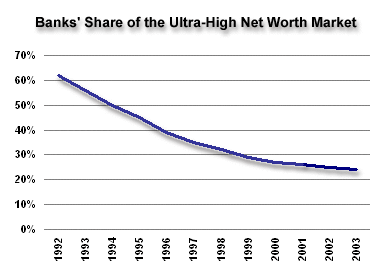Bank-Affiliated Brokerage Divisions
Abstract
| Boston, MA, USA February 13, 2004 Banks only account for 24 percent of the ultra-high net worth market, compared to over 60 percent in the early 1990s.  Banks face an uphill battle in their effort to sell more brokerage products to their clients. Brokerage firms have continually been one step ahead of banks; they introduced innovative products, offered open architectures and hired capable and sales-oriented individuals long before most banks even contemplated doing so. Banks lost a significant amount of business to brokerage firms in the 1990s and have been struggling to stem the flow ever since. U.S. banks account for just 17 percent of mutual funds sales, one percent of life insurance sales and less than three percent of managed account sales. They only account for 24 percent of the ultra-high net worth market, compared with 60 percent for brokerage and, to a much lesser extent, mutual fund firms. In a new report, ,Celent examines precisely what has held banks back and what they can do to become legitimate investment providers. There are, in fact, reasons for optimism. Banks appear to be having success luring advisors from brokerage firms and their recent sales of managed accounts葉heir market share increased from 3.8 percent to 5.8 percent from September 2002 to September 2003擁ndicates they are becoming competitive in what has become a critical market. "By targeting the mass affluent用eople who are more likely to use bank branches for their investment needs than others and who are typically still in the accumulation stage of their lives banks are making good use of their resources," says Adam Josephson, research analyst in the securities and investments group at Celent and author of the report.This report profiles the strategies of BB&T, JPMorgan Chase, RBC Financial Group and a large North American bank that wishes to remain anonymous. A is available online. |
of Celent Communications' Retail Securities & Investments and Retail Banking research services can download the report electronically by clicking on the icon to the left. Non-members should contact info@celent.com for more information. |
|

